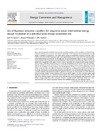Identificador persistente para citar o vincular este elemento:
https://accedacris.ulpgc.es/jspui/handle/10553/43803
| Título: | Use of Bayesian networks classifiers for long-term mean wind turbine energy output estimation at a potential wind energy conversion site | Autores/as: | Carta, José A. Velázquez, Sergio Matías, J. M. |
Clasificación UNESCO: | 3322 Tecnología energética 1208 Probabilidad |
Palabras clave: | Bayesian network Measure–correlate–predict Long-term records Method of bins Wind speed |
Fecha de publicación: | 2011 | Editor/a: | 0196-8904 | Publicación seriada: | Energy Conversion and Management | Resumen: | Due to the interannual variability of wind speed a feasibility analysis for the installation of a Wind Energy Conversion System at a particular site requires estimation of the long-term mean wind turbine energy output. A method is proposed in this paper which, based on probabilistic Bayesian networks (BNs), enables estimation of the long-term mean wind speed histogram for a site where few measurements of the wind resource are available. For this purpose, the proposed method allows the use of multiple reference stations with a long history of wind speed and wind direction measurements. That is to say, the model that is proposed in this paper is able to involve and make use of regional information about the wind resource. With the estimated long-term wind speed histogram and the power curve of a wind turbine it is possible to use the method of bins to determine the long-term mean energy output for that wind turbine. The intelligent system employed, the knowledgebase of which is a joint probability function of all the model variables, uses efficient calculation techniques for conditional probabilities to perform the reasoning. This enables automatic model learning and inference to be performed efficiently based on the available evidence. The proposed model is applied in this paper to wind speeds and wind directions recorded at four weather stations located in the Canary Islands (Spain). Ten years of mean hourly wind speed and direction data are available for these stations. One of the conclusions reached is that the BN with three reference stations gave fewer errors between the real and estimated long-term mean wind turbine energy output than when using two measure–correlate–predict algorithms which were evaluated and which use a linear regression between the candidate station and one reference. | URI: | https://accedacris.ulpgc.es/handle/10553/43803 | ISSN: | 0196-8904 | DOI: | 10.1016/j.enconman.2010.09.008 | Fuente: | Energy Conversion and Management [ISSN 0196-8904], v. 52 (2), p. 1137-1149 |
| Colección: | Artículos |
Citas SCOPUSTM
49
actualizado el 08-jun-2025
Citas de WEB OF SCIENCETM
Citations
38
actualizado el 08-jun-2025
Visitas
100
actualizado el 23-ene-2024
Descargas
234
actualizado el 23-ene-2024
Google ScholarTM
Verifica
Altmetric
Comparte
Exporta metadatos
Los elementos en ULPGC accedaCRIS están protegidos por derechos de autor con todos los derechos reservados, a menos que se indique lo contrario.
